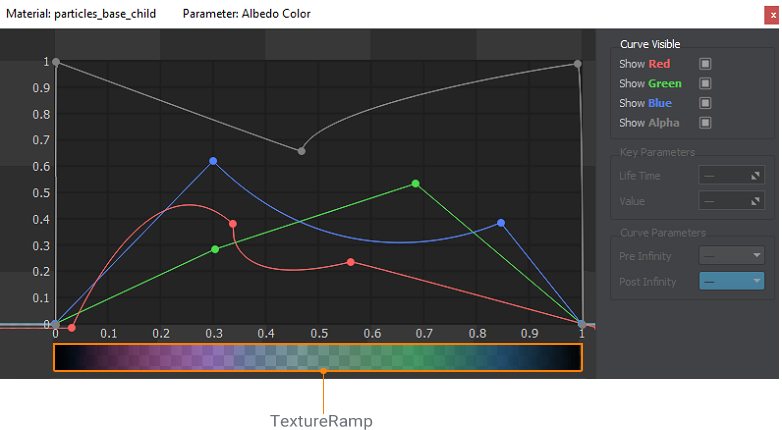Unigine::TextureRamp Class
| Header: | #include <UnigineTextures.h> |
Interface for handling ramp textures. This class lets the user store 2d curves in a form of a texture (convert vectors to raster data).
Ramp textures can be used for color variation in the particles_base material of Particle Systems or in other custom materials.

You can set up to 4 channels for the ramp texture.
TextureRamp Class
Members
static TextureRampPtr create ( int num_channels, int resolution, int flags ) #
Sets resolution, number of channels and texture flags for this TextureRamp instance. The pointer to the ramp texture is set to null and curves are marked for an update.Arguments
- int num_channels - Number of texture channels.
- int resolution - Width resolution of the ramp texture.
- int flags - Texture flags.
static TextureRampPtr create ( const Ptr<TextureRamp> & texture_ramp ) #
Ramp texture constructor. Creates a new ramp texture by copying a given source ramp texture.Arguments
- const Ptr<TextureRamp> & texture_ramp - Pointer to a new ramp texture.
TextureRamp ( ) #
Ptr<Texture> getTexture ( ) const#
Creates a new texture and updates hashes for curves, if required. Returns a pointer to the texture or null if the texture was not created.void releaseTexture ( ) #
Deletes the texture and its pointer.void copy ( const Ptr<TextureRamp> & src_texture_ramp ) #
Copies the data of a source ramp texture to the texture.Arguments
- const Ptr<TextureRamp> & src_texture_ramp - Source ramp texture.
Ptr<TextureRamp> clone ( ) const#
Duplicates the ramp texture and returns a pointer to the copy.Ptr<Curve2d> getCurve ( int channel ) const#
Returns a pointer to the Curve2d for the specified channel.Arguments
- int channel - Required channel.
Return value
Pointer to a Curve2d object.void setNumChannels ( int channels ) #
Sets the new number of channels for the texture.Arguments
- int channels - Number of texture channels.
int getNumChannels ( ) const#
Returns the number of texture channels.void setResolution ( int resolution ) #
Sets the width resolution for the texture.Arguments
- int resolution - Texture width resolution.
int getResolution ( ) const#
Returns the texture width resolution.void setFlags ( int flags ) #
Sets texture flags.Arguments
- int flags - Texture flags.
int getFlags ( ) const#
Returns texture flags.void * addChangedCallback ( Unigine::CallbackBase * func ) #
Adds a callback function to be called on changing the ramp texture. The signature of the changed callback function must be as follows:Source code (C++)
void changed_callback_function_name();You can set a callback function as follows:
Source code (C++)
addChangedCallback(MakeCallback(changed_callback_function_name));Arguments
- Unigine::CallbackBase * func - Callback pointer.
Return value
ID of the last added changed callback, if the callback was added successfully; otherwise, nullptr. This ID can be used to remove this callback when necessary.bool removeChangedCallback ( void * id ) #
Removes the specified callback from the list of changed callbacks.Arguments
- void * id - Changed callback ID obtained when adding it.
Return value
True if the changed callback with the given ID was removed successfully; otherwise false.void clearChangedCallbacks ( ) #
Clears all added changed callbacks.void setDefaultCurve ( int channel, const Ptr<Curve2d> & default_curve ) #
Resets a curve for the given channel to a default one.Arguments
- int channel - R, G, B, or A channel set by the corresponding value from 0 to 3.
- const Ptr<Curve2d> & default_curve - A curve to be used as the default one.
bool isDefault ( int channel ) const#
Returns a value indicating if the value of the given curve channel is the default one which was previously set via setDefaultCurve.Arguments
- int channel - R, G, B, or A channel set by the corresponding value from 0 to 3.
Return value
true if the curve value is the default one set via setDefaultCurve, otherwise false.bool isDefaultAll ( ) const#
Returns a value indicating if the values of all curve channels are the default ones which were previously set via setDefaultCurve.Return value
true if the values of all curve channels are the default ones set via setDefaultCurve, otherwise false.void save ( const Ptr<Xml> & xml ) #
Saves the ramp texture data to the given Xml node.Arguments
void save ( const Ptr<Json> & json ) const#
Saves the ramp texture data to the given Json class instance.Arguments
void load ( const Ptr<Xml> & xml ) #
Loads the ramp texture data from the given Xml node.Arguments
void load ( const Ptr<Json> & json ) #
Loads the ramp texture data from the given Json class instance.Arguments
void saveState ( const Ptr<Stream> & stream ) const#
Saves the state of the ramp texture into a binary stream.Example using saveState() and restoreState() methods:
Source code (C++)
// initialize a node and set its state
//...//
// save state
BlobPtr blob_state = Blob::create();
ramp->saveState(blob_state);
// change state
//...//
// restore state
blob_state->seekSet(0); // returning the carriage to the start of the blob
ramp->restoreState(blob_state);Arguments
void restoreState ( const Ptr<Stream> & stream ) const#
Restores the state of the ramp texture from the binary stream.Example using saveState() and restoreState() methods:
Source code (C++)
// initialize a node and set its state
//...//
// save state
BlobPtr blob_state = Blob::create();
ramp->saveState(blob_state);
// change state
//...//
// restore state
blob_state->seekSet(0); // returning the carriage to the start of the blob
ramp->restoreState(blob_state);Arguments
Last update:
2023-06-23
Help improve this article
Was this article helpful?
(or select a word/phrase and press Ctrl+Enter)